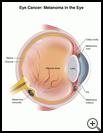
Eye Cancer: Melanoma in the Eye
________________________________________________________________________
KEY POINTS
- Melanoma is an uncontrolled, abnormal growth of cells in the eye.
- If melanoma in the eye grows, it can spread to other parts of your body. The main goal of treatment is to limit the growth and spread of the disease. Eye melanoma may be treated with surgery, radiation therapy, or laser therapy.
________________________________________________________________________
What is melanoma in the eye?
Melanoma is an uncontrolled, abnormal growth of cells in the eye. The parts of the eye most often affected by this rare type of cancer are:
- The iris, which is the colored part of the front of your eye that surrounds the pupil
- The ciliary body, which is a muscle that helps your eye focus and makes the fluid that fills the front of your eye
- The choroid, which is a layer of tissue in the back of your eye, behind the retina (the lining at the back of the eye that senses light coming into your eye)
The location of the melanoma affects its symptoms and treatment.
What is the cause?
Melanoma in the eye happens when cells that produce pigment grow uncontrollably. Pigment produces the coloring of the skin and iris of your eye. What causes the abnormal growth of cells is not known. People with light-colored skin and eyes may have a higher chance of developing melanoma than people with darker skin. Exposure to ultraviolet (UV) rays from sunlight or tanning beds increases your risk. Rarely, this type of cancer starts in another part of the body and spreads to your eye.
What are the symptoms?
Often melanoma cause no symptoms. Sometime melanoma in the eye can cause:
- Painful, red eyes
- A dark spot on the iris
- Blurry vision in one eye or loss of side vision
- Flashing lights or floating spots in your vision
How is it diagnosed?
The tumor is usually found during a routine eye exam before you start having symptoms. If your provider sees a tumor, you may have an ultrasound scan to see what kind of tumor it is.
How is it treated?
If melanoma in the eye grows, it can spread to other parts of your body. The main goal of treatment is to limit the growth and spread of the disease.
Common types of treatment are:
- Surgery to remove the tumor and affected parts of the eye. Sometimes the whole eye must be removed.
- Internal radiation therapy, which uses small implants of radioactive material placed on the outside wall of the eye over the tumor to kill cancer cells and shrink the tumor.
- External beam irradiation therapy, which uses high-energy rays to kill cancer cells and shrink tumors.
- Laser therapy, which uses a very powerful beam of light to destroy the tumor or blood vessels that feed the tumor.
Blood tests and imaging studies such as X-rays, CT scans, PET scans, or an MRI may be done to see if the cancer has spread. These tests may need to be repeated regularly.
Recovery depends on the size and cell type of the cancer, where the cancer is in your eye, and whether the cancer has spread. If the cancer has not spread to other parts of the body, the long-term survival rates are good. Although saving your vision is a goal, it is often not possible to treat the tumor without some vision loss.
How can I take care of myself?
Follow the full course of treatment your healthcare provider prescribes. Ask your healthcare provider:
- How and when you will get your test results
- How long it will take to recover
- If there are activities you should avoid and when you can return to your normal activities
- How to take care of yourself at home
- What symptoms or problems you should watch for and what to do if you have them
Make sure you know when you should come back for a checkup. Keep all appointments for provider visits or tests.
How can it be prevented?
There is no known way to prevent melanoma in the eye. Wearing sunglasses or hats when outdoors to limit exposure to UV light may help reduce your risk.

